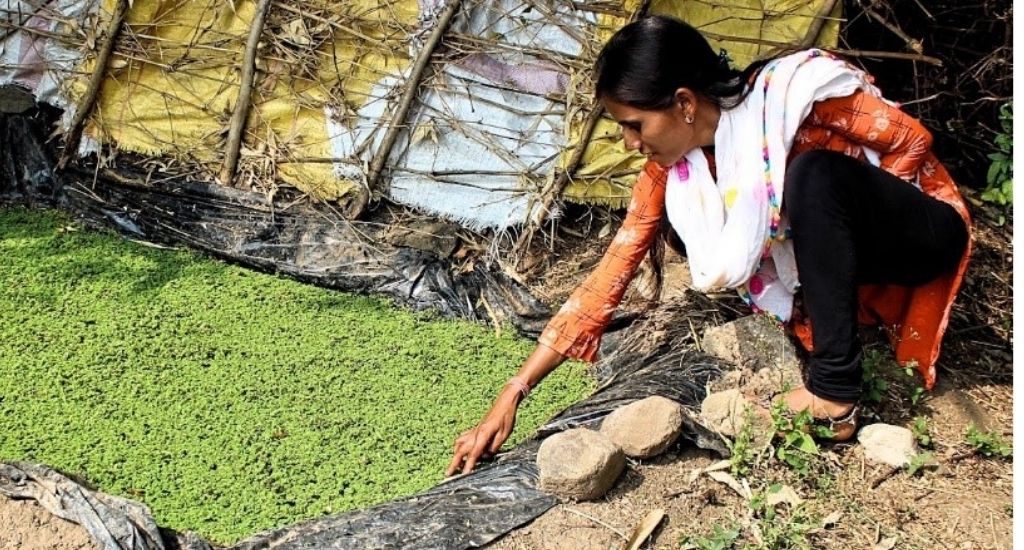
Azolla “water weed” becomes cattle superfood
With the cost of maintaining livestock a constant burden for most poor farmers, azolla goes from being a pesky water weed to a sustainable and cost-effective superfood for cattle.

With the cost of maintaining livestock a constant burden for most poor farmers, azolla goes from being a pesky water weed to a sustainable and cost-effective superfood for cattle.
One of the biggest hurdles cattle farmers face is the cost of keeping their livestock fed.
Enter: azolla – the aquatic fern. It is considered a pesky water weed by some but is becoming the new superfood for cattle.
Going by an array of colourful names – from mosquito fern to fairy moss to water velvet – it develops as an exquisite green mat over a water body.
It is not only one of the fastest growing plants on Earth, but since it is an aquatic plant it does not require soil to grow. Containing a rich mix of protein, minerals and vitamins, it is a remarkably low-cost and high-nutrient fodder for livestock.
Rajpur, a small town and panchayat in the Barwani District of Madhya Pradesh, is piloting the use of azolla as a sustainable, low cost, low energy and low maintenance feed for cattle with promising results.
This pilot project, anchored by the Transforming Rural India Foundation (TRIF), now aims to expand the use of azolla by introducing it in more administrative blocks and districts in Madhya Pradesh.
Many villagers in Rajpur say that since they started using azolla as fodder for their cattle, the milk yield has doubled and the animals are healthier than before. (ALSO READ: Tamil farmers innovate to overcome fodder shortage)
Abhishek Gupta, the TRIF block manager, admits that before the pilot project, even he did not know of this amazing plant and its vast potential for helping farmers.
“When I saw what a difference it made, I was amazed. I wondered why all the villagers weren’t using it?” he said.
Azolla has unique properties, getting its nitrogen from the atmosphere. It produces not just biofertilisers and livestock feed, but is also fit for human consumption. It can also be used as a biofuel.
It is the women in the pilot programme who have become azolla ambassadors, proving vital in spreading awareness. They encourage more families to use azolla for their livestock. They tell others how low-cost and easy to use it is, never mind its sustainability.

The National Bank for Agriculture and Rural Development (NABARD) is also encouraging the use of azolla as part of their livelihood activity under their Watershed Development Fund (WDF).
NABARD’s demonstration units have inspired several dairy farmers to set up azolla units.
To grow azolla, a two feet deep pit, approximately 3ft by 5ft in length and width, is required.
The pit is lined with a plastic sheet and filled with water, mud and cow dung. Then a fistful of azolla is added to the water. In just six to eight days, the entire pit becomes covered with azolla that can be fished out and fed to livestock.
This low maintenance process remains sustainable as it does not require any investment for upkeep or any expensive equipment or chemicals.

The water from the pit can be refilled as needed, while the azolla continues to grow even with seasonal changes.
As per NABARD’s estimation, setting up an azolla fodder plot of about 8 ft by 5 ft costs Rs 1,800 approximately.
In the Neemuch district of Madhya Pradesh supplementing azolla in cattle diets caused the milk yield of buffaloes to increase by 13.8%. The fat content in the milk also improved.
Women from the villages of Rajpur panchayat too reported that azolla has helped in improving the overall health of their animals. Weak and old ones consuming azolla as a part of their feed, gain strength and become viable for agricultural purposes. Cows and buffaloes that stopped producing milk, have also been reported to start yielding milk again. The results can be seen as early as within two weeks of regular feeding.
Chanda Kaushal, a resident of the Nanded village, started feeding azolla mixed with wheat flour to her buffalo.

“It has increased my buffalo’s milk yield by almost 1.5 litres,” she said.
She is now actively encouraging other women in the community to incorporate azolla in their cattle’s diets.
Boasting of its successful reception in the village, TRIF block manager Gupta said when villagers see the improvement in the milk yield and the health of their animals, they realise its usefulness.
“Then they want to continue using it and become ‘azolla ambassadors’, spreading the word to neighbouring villages as well,” he said.
Vanya Gupta is the Communications and Outreach Manager at Transforming Rural India Foundation.